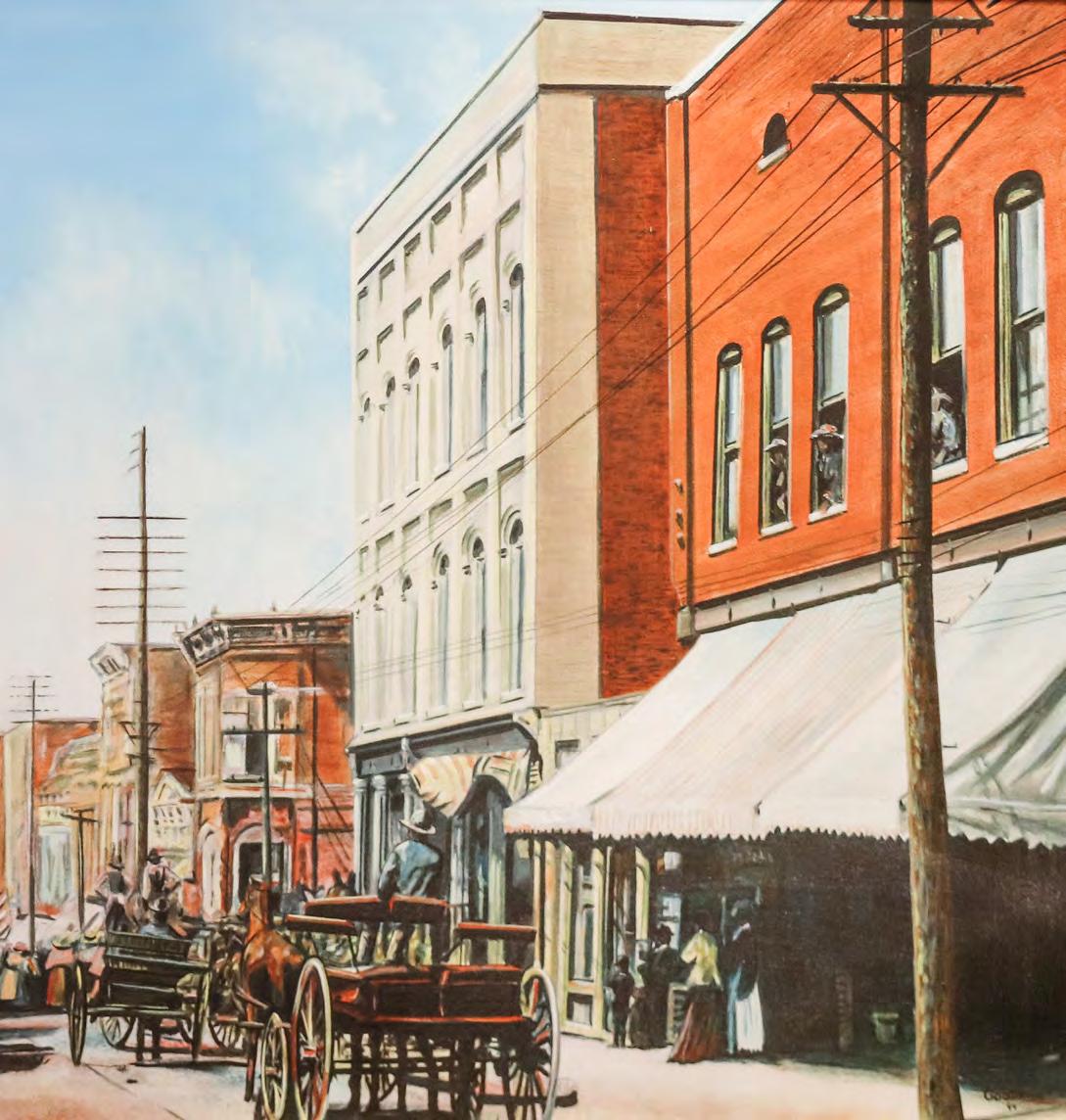
VOLUME 2, NO. 1 OCTOBER / NOVEMBER / DECEMBER 2022
C larksville-Montgomery County, Tennessee
931.552.0654 www.plantersbankonline.com Making Great Things Happen. Proudly serving Tennessee and Western Kentucky with 12 convenient locations. A 25 Year Tradition MEMBER FDIC
EXECUTIVE DIRECTOR
Frank
Lott
MANAGING EDITOR
Becky Wood
ART DIRECTION & DESIGN
Yvette
Campagna
PHOTOGRAPHY
& MARKETING
Maegan Collins
MEMBERSHIP & MARKETING COMMITTEE CHAIRMAN
Larry Richardson
CONTRIBUTING WRITERS
Kemeliz Fuentes
Cresta McGowan
Kate Tallman
CONTRIBUTING PHOTOGRAPHERS
Karla Tucker
Ava Vienneau
HISTORY, ARTS AND CULTURE INTERSECT AT THE CORNER OF SECOND & COMMERCE
Thank you, Clarksville-Montgomery County, for the warm reception and support you have given our fledgling Second & Commerce quarterly journal. When Volume 1, No. 1 launched in October 2021, we collectively held our breath and hoped for the best. The positive response was immediate and very encouraging to our entire Museum staff.
The mission of this publication is to foster creativity and champion our area’s unique cultural diversity. SECOND & COMMERCE expands the Customs House Museum & Cultural Center’s purpose through supporting the arts community, exploring local history and telling stories about the past, present and future of Clarksville.
Lott EXECUTIVE DIRECTOR
Bringing a new publication to life is, at best, a very calculated risk. Any one of the myriad moving parts required to produce a magazine can “go south” and leave a publisher in a state of high anxiety. Our first year of publication has proven to be a mix of great exuberance and nail-biting frustration. I must admit that in all my years spent in marketing communications, public relations and publishing, the thrill of seeing ink on paper is still a magical moment.
The S&C editorial team led by our very talented Managing Editor, Becky Wood, has been both diligent and open-minded in searching out and selecting interesting story ideas, then allowing contributing writers to dive deep into their assignments. The resulting compendium of articles that compose the first four issues in Volume 1 has already established a base of evergreen content that S&C will continue to build upon. My desire is that many of our readers accumulate a bookshelf of back issues, because they feel we are connecting them with stories that have context for them… stories of our shared history and culture… stories they want to keep, and perhaps even pass on.
I have often used this phrase when speaking about how a “successful” project happens, and I feel that the initial success of Second & Commerce fits the same pattern. Success happens when opportunity, need and commitment all converge at the right time and place. Sounds simple, doesn’t it?
Enjoy Issue No. 1 of Volume 2!
CUSTOMS HOUSE MUSEUM & CULTURAL CENTER BOARD OF TRUSTEES
Jamie Durrett, Chair
Thomasa Ross, Vice Chair
Paige Adkins
Frazier Allen Dan Black Kell Black
Christina Clark* Joe Creek* Jim Diehr Darwin Eldridge Lawson Mabry Linda Nichols
Brendalyn Player
Larry Richardson

Vondell Richmond* Wes Sumner
Eleanor Williams*
*denotes ex-officio

SECOND & COMMERCE / 1
HOURS OF OPERATION Tuesdays–Saturdays 10 am–5 pm Sundays 1–5 pm Closed Mondays customshousemuseum.org @customshousemuseum #customshousemuseum
Frank


2 / SECOND & COMMERCE 1 / Director’s Letter 4 / Happening at the Museum 8 / Member Spotlight 26 / Seasons: The Museum Store 30 / The Postscript 32 / Connect with Us TABLE OF CONTENTS CONTACT Advertising Inquiries Arts & Culture Events Article Submissions Please email Becky Wood at becky@customshousemuseum.org. customshousemuseum.org/ secondandcommerce The Clarksville Montgomery County Historical Museum (d.b.a. Customs House Museum & Cultural Center) is designated by the IRS as a 501 (c)(3) non-profit organization. © Customs House Museum & Cultural Center 2022-10/2022-4M Franklin Street Danny Goodrum, 1994 Oil on board ON THE COVER: Located at 116 N 2nd St. in Historic Downtown Clarksville mailroomtn.com | @mailroomtn
IN THIS ISSUE / FEATURES
Live and Let Fly
With a license to thrill, the 38th annual Flying High raised an unprecedented amount of money for the Museum and its mission – and inspired a remarkable community donation.

Unidos: Inclusivity for a Stronger Nation
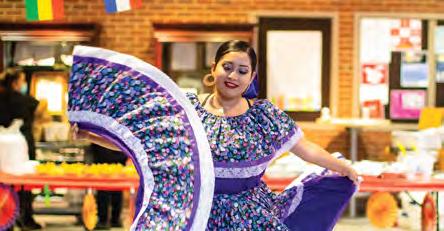
National Latinx and Hispanic Heritage Month is observed from September 15 to October 15 every year. To celebrate, Austin Peay State University’s Latino Community Resource Center presents “The Latinx Experience” with a plethora of events and programs throughout the month.
Lori Putnam: Far from Home
Lori Putnam credits her creative spirit to her upbringing in the Tennessee countryside. After exploring local scenes in her 2021 show Close to Home, her newest solo exhibition takes inspiration from her travels around the world.

New Deal Intrigue
In the 1930s, artist Francis Luis Mora was commissioned to paint two murals for the newly-constructed U.S. Post Office on North Second Street. The murals depicted a slice of local history and hung in the Federal Building for over 25 years... but what ever happened to them?

Reinventing The Mailroom
As one of the newest restaurants to open in Downtown Clarksville, The Mailroom pays homage to the Federal Building’s history and the spirit of the post office in more ways than one.
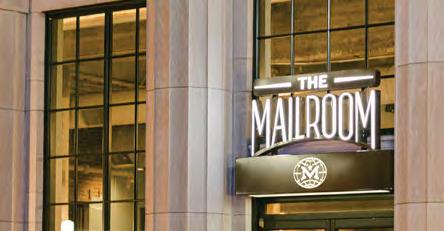
Collections Spotlight: Halloween Delivered
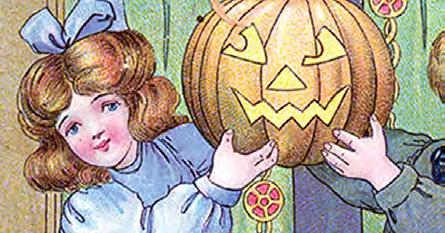
From jack-o-lanterns and black cats to witches and cauldrons, learn about the “Golden Age” of postcards with these vintage Halloween mailers, which are some of the earliest items donated to the Museum’s archives.
Highlighting Tennessee Artists
Member organizations around the world provide artists with a platform to exhibit their work, share their process with the public and build a creative community. This special combination of individual expression and collective passion is on display in upcoming exhibits from the Nashville Artist Guild and the Tennessee Watercolor Society.

SECOND & COMMERCE / 3
/
22
10 /
13 /
5 /
16 /
/
23
/
28
Of

Lori
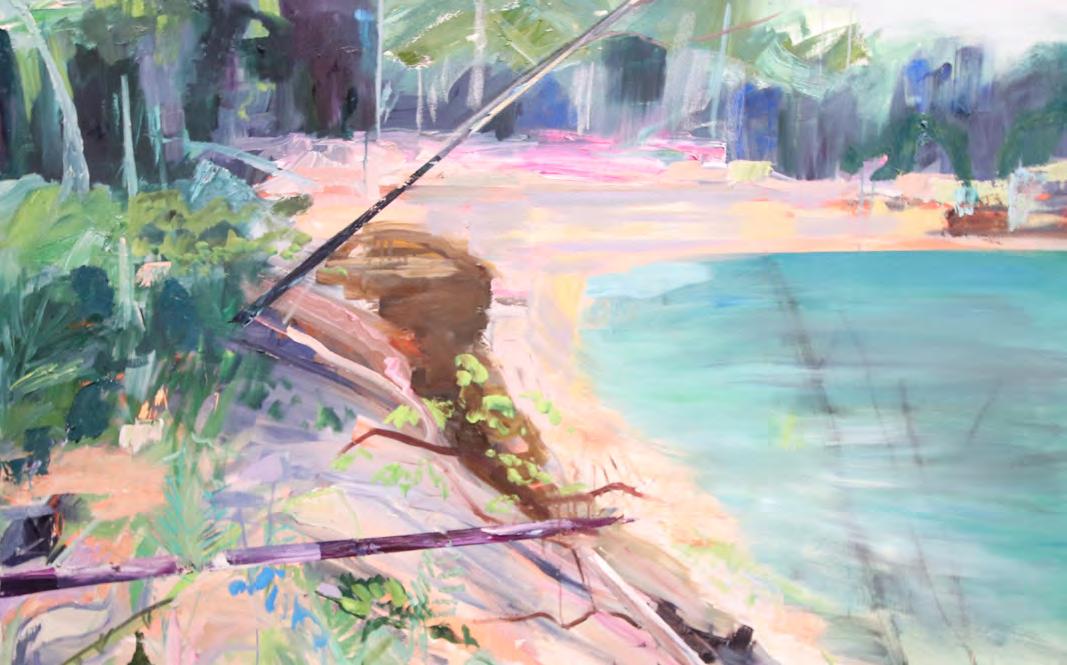
4 / SECOND & COMMERCE you might not know we have life, home, auto, and business insurance. now you do. simple human sense® 931.552.4314 mscinsurance.com INSURANCE
The
the
Laurén
The Art
the Collection
of the
27
Illumination:
Art of Dr. John Stanton THROUGH OCTOBER 16 Thomas Adams: Pen & Inks from
Collection THROUGH OCTOBER 19 Peripheries: New Work by
Brady THROUGH OCTOBER 30
of Clarksville THROUGH OCTOBER 26 Spookies from
THROUGH NOVEMBER 6 Art
Nashville Artist Guild OCTOBER 4 – NOVEMBER
A Simpler Life: Photographs by Carl Wilson
OCTOBER 19 – JANUARY 2
Thread & Lace NOVEMBER 1 – JANUARY 1
Putnam: Far from Home NOVEMBER 3 – JANUARY 3
Vestige: Artists Creating Through Grief NOVEMBER 5 – JANUARY 1 Salute the Military NOVEMBER 9 – NOVEMBER 27
Jill Mayo: Paper Dreams DECEMBER 1 – JANUARY 29
UPCOMING EXHIBITIONS Learn about Museum exhibits, programs and more at customshousemuseum.org.
Tennessee Watercolor Society DECEMBER 1 – JANUARY 29
Something spectacular happened this year at Flying High, the Customs House Museum & Cultural Center’s largest annual fundraiser. On July 16, over 400 Museum supporters and guests gathered at Oak Grove Racing, Gaming & Hotel for the 38th annual gala and raised a record-breaking amount of money for the Museum and its mission. Against the backdrop of a glamorous Bond-inspired event, attendees had the opportunity to bid on a variety of unique art and experiences through live and silent auctions. The live auction concluded with an unprecedented and poignant donation regarding artist Kitty Harvill’s signature piece, a watercolor entitled Peg's Pony.
FLYING HIGH 2022 BREAKS MUSEUM FUNDRAISING RECORDS


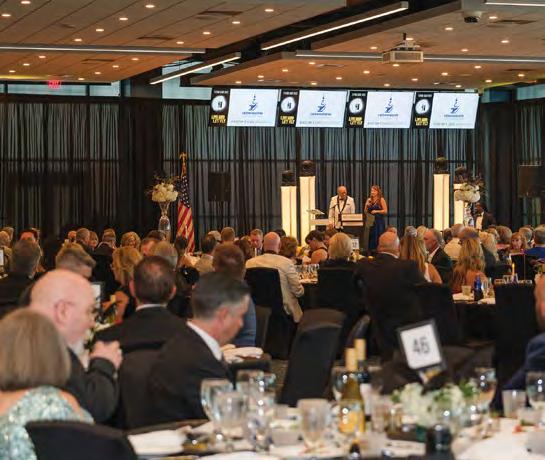
 BY MAEGAN COLLINS, MARKETING COMMUNICATIONS MANAGER
BY MAEGAN COLLINS, MARKETING COMMUNICATIONS MANAGER

As Peg's Pony was uncovered at the Flying High Preview Party in June, Kitty’s heartfelt backstory brought many emotions to the crowd. Kitty’s late mother, Peg Harvill, and her heavy involvement in the early days of the Museum was a focal point of the piece. The painting meant so much to Kitty, and it was also special to many people who have been longtime Museum supporters. Shortly after the piece was unveiled to the public, a passionate group of 30 community members, spearheaded by former First Federal Savings Bank CEO & President Jim Mann, initiated a plan to join together to buy the signature piece and donate it back to the Museum. In a few short weeks, they collected $32,900 to purchase the painting.
At Flying High, when it was time for Peg's Pony to be auctioned off, this astounding donation was announced to those in attendance. The monumental contribution clearly had an effect on the crowd, and more supporters donated to this cause for a total of $56,950 raised by 68 people to collectively donate the
SECOND & COMMERCE / 5
artwork back to the Museum. This broke records as the most money raised for a Flying High signature piece, and everyone is delighted that such an emotional and significant work of art will get to hang in the Museum for all to enjoy.
The painting will hang in the 1898 Customs House building, near the location of the painted scene. A plaque honoring those that donated to the cause will hang alongside the story of the work. Museum visitors for years to come will have the opportunity to appreciate this amazing piece of art, one family’s legacy and the impact every individual can have on the community at large.

Altogether, this year’s Flying High raised a total of $245,538 for the Museum’s exhibits, educational programming, artifact preservation and more.
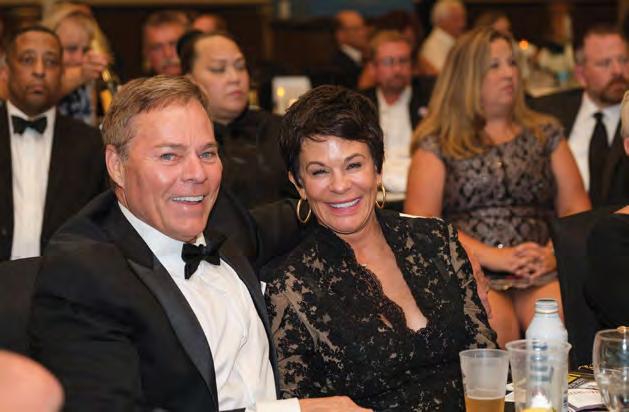

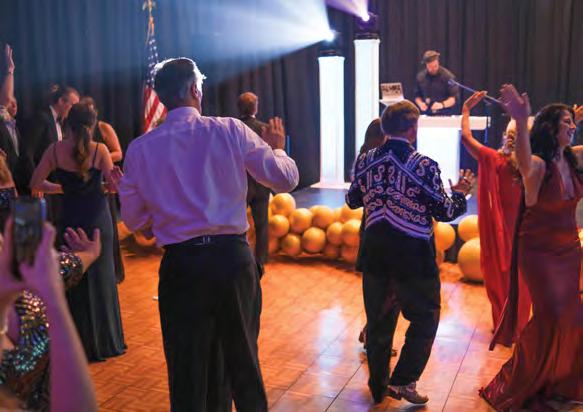


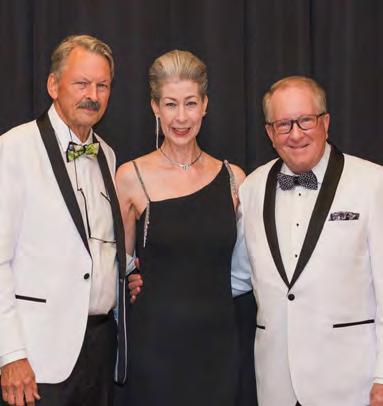

 Photos by Karla Tucker
Photos by Karla Tucker









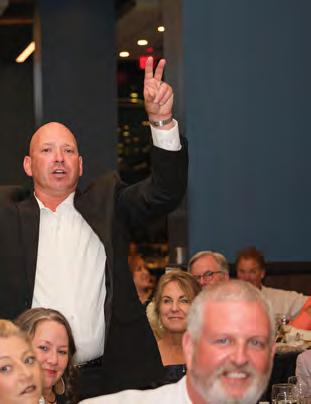
SECOND & COMMERCE / 7 Pottery Studio | Art Gallery 115 Franklin St. Clarksville, TN Rivercityclay@gmail.com 931-542-6615 BRINGING THE ART OF HANDMADE POTTERY TO DOWNTOWN CLARKSVILLE Rivercityclay.com LET YOUR CLAY JOURNEY SHOP. BOOK A CLASS. BEGIN.
Solie Fott always knew he’d pursue a life in music, ever since he received a violin for his sixth birthday.
“My mother decided that for me — her only child was going to be the world’s greatest violinist... Well, that didn’t happen,” he recalled with a smile.
A self-proclaimed fiddle player from Chattanooga, Fott spent time as a violinist in the Chattanooga and Nashville Symphonies
MEMBER SPOTLIGHT: Dr. Solie Fott
BY BECKY WOOD, MANAGING EDITOR
before continuing his career as a professor of music and session musician for iconic artists. Truly a modern renaissance man, he is a connoisseur of fine wines, a master of puns and wordplay, an avid collector of art and kaleidoscopes, a mean bridge player and a dedicated advocate of the Customs House Museum & Cultural Center.
Dr. Fott came to Clarksville in 1958 when he took a “one-year” teaching gig at Austin Peay State University. “A fellow fiddler in the Nashville Symphony told me he had just gotten a year’s leave of absence [at APSU] to start work on his doctorate, and asked me to take his place for a year,” explained Fott. “If you happen to run into Ed Stover, tell him I waited 42 years for him to come back.”
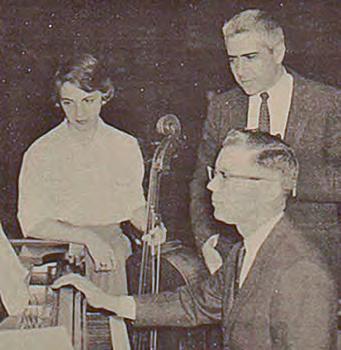

In addition to conducting the orchestra and various string courses, Fott found special enjoyment in teaching music appreciation classes, reveling in the opportunity to build young audiences and broaden their musical horizons. Now a professor
emeritus, Fott retired from APSU in 2000 after more than four decades in which he was the founding president of the faculty senate, worked to establish the Center of Excellence for the Creative Arts and served as chair of the music department for 20 years.

“He contributed mightily to the atmosphere of the music department because of his musicianship, and as chair, he was always advocating for the department at every level,” said Dr. Sharon Mabry, who retired in 2022 after a record 52 years as a music professor at Austin Peay. “His door was always open, and he was a great person to go to for advice.”
It is clear that Fott’s time as an educator has made a profound impact on his life. “He has an incredible memory, I suspect he remembers the name of every student he ever taught,” continued Mabry. “Even today, he tells stories about former students and can remember every detail – even 40 years back.”
To supplement his teaching income throughout the 1960s and 70s, Fott began working as a session musician in Nashville. Making the drive along 41A to and from the studios of Music Row, Fott participated in over 2,000 recording sessions that resulted in an incredible discography full of albums by Patsy Cline, Roy Orbison, Johnny Cash, Elvis Presley and many others.
His interest in the arts extends far beyond music alone, and in the 1950s, he began collecting art with his late wife Mary. “We saw an awful lot of pictures that we could not afford... but if you decide that you can eat hamburgers instead of cheeseburgers, that saves enough money where you can splurge a little bit and buy something.” He started collecting kaleidoscopes in the early 1990s, inspired by Mary’s penchant for collecting niche Santa Clauses. He now owns over 400 of the optical instruments, and one-of-a-kind art lines the walls of his Clarksville home.
8 / SECOND & COMMERCE
TOP: Dr. Fott (top right) prepares for an APSU faculty recital with Joanne Hackman and Dr. Thomas Cowan. The All State, February 26, 1963
Austin Peay State University Felix G. Woodward Library, Archives & Special Collections
MIDDLE: Solie Fott sits for an interview. Courtesy of the Clarksville Community Network
BOTTOM: Solie Fott with his sons, David and Galen. Courtesy of the Fott Family
“Solie has not only been a consistent supporter of the Museum, but that of the exhibiting artists who have come through our galleries over the years,” said Terri Jordan, Curator of Exhibits. “His eye for talent and quality of technique have given validation to artists, at all points in their careers, with the financial support from his purchases. It is always a great trip down memory lane for me personally when I get to revisit these great works of art at the Fott home.”
Fott retired from APSU in 2000 after more than four decades in which he was the founding president of the faculty senate, worked to establish the Center of Excellence for the Creative Arts and served as chair of the music department for 20 years.

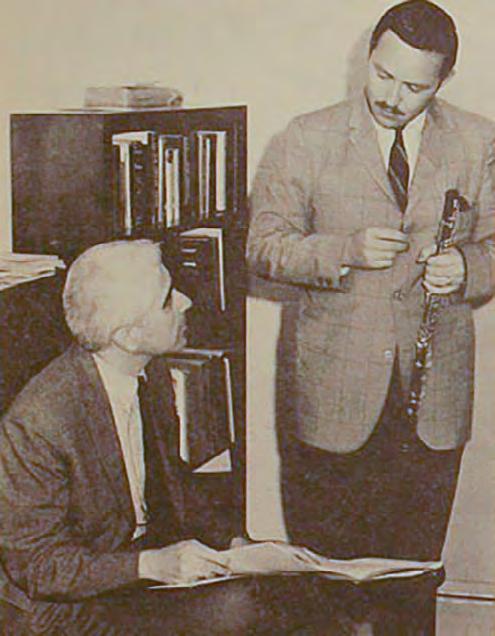

For his exceptional and loyal friendship to the Museum, which included a six-year term on the Board of Trustees, Fott was the recipient of the 2022 Gracey Award to recognize his valuable gifts of time, treasure and talent to this community institution. Overall, Dr. Fott feels lucky to have supported his life and family through education and music.
“There are so many people on the planet Earth who hate to get up in the morning and go to work,” he mused. “When a man’s responsibilities coincide with what makes him happy, that is a fortunate life, and I have felt very fortunate.”
customshousemuseum.org/become-a-member
SECOND & COMMERCE / 9
Dr. Solie Fott directs the APSU Orchestra during their 1975 Winter Concert. Farewell and Hail, 1975
Austin Peay State University Felix G. Woodward Library, Archives & Special Collections
MIDDLE: Dr. Fott accepts the 2022 Gracey Award from Executive Director Frank Lott and Board Chairwoman Jamie Durrett at Flying High. Photo by Karla Tucker
BOTTOM: Dr. Fott, conductor of the university orchestra, makes plans for an upcoming concert with featured oboist Dr. T. H. Keahey.
The All State, May 21, 1969
Austin Peay State University Felix G. Woodward Library, Archives & Special Collections
Celebrating Latinx Heritage Month with APSU’s Latino Community Resource Center

Unidos: Inclusivity for a Stronger Nation
 BY KEMELIZ FUENTES
BY KEMELIZ FUENTES
Many perceive the Latinx community as a homogeneous body, but unity does not only derive itself from similitude, but from the recognition and celebration of all differences within Latinx cultural groups. This year’s national theme for Latinx Heritage Month, “Unidos: Inclusivity for a Stronger Nation,” tackles these concepts in bringing Latinx people and this nation closer together to build a brighter future.
Unity and inclusivity were at the core of why Austin Peay State University’s Hispanic Cultural Center rebranded to the Latino Community Resource Center (LCRC) in 2019. The word “Hispanic” does not include indigenous or nonSpanish-speaking groups, and its roots are often associated with Spanish colonialism in America. Yanaraliz Barnes, the director of the LCRC, understood that “Latino” represents more of the community.
“‘Hispanic’ refers to language, and ‘Latino’ refers to area,” explained Barnes. “While Spanish is
the most-spoken language in Latin American and the Caribbean, it is not the only language. Indigenous languages, Portuguese, English, German, Italian and more are also spoken in this region.”
With the name change, Barnes also adjusted the programs, resources and events to focus on the recruitment, retention and graduation of the Latinx
Austin Peay State University’s Latinx Heritage Month Planning Committee established a university-specific theme for 2022 in “The Latinx Experience.” Through a variety of programs planned throughout the month (which is observed September 15 through October 15), the committee aimed to promote inclusivity and intersectionality, even with the name and the theme itself. Since the Spanish language is gender-based, the “x” in “Latinx” encourages people to stop, think and have meaningful conversations regarding identity within the Latinx community. The “x” gives everyone the opportunity to present themselves as they personally believe. This year’s theme explores unity as we all collaborate, reflect and offer ideas on how we can all be more inclusive and celebrate our differences.
community at APSU. She wanted the LCRC to be a known resource to students, and also extend its roots to the greater Clarksville community and beyond.
To begin, the committee stressed the importance of recognizing that the Latinx experience is not only lived by people here today, but has grown from the early ancestors of today’s
10 / SECOND & COMMERCE
This year, we celebrate the Latinx experience of yesterday, today and tomorrow.
community – the Indigenous peoples of our history. Artist and head of the committee’s marketing, Gabriel Fonseca, felt inspired to honor and celebrate Indigenous culture through this year’s theme and design. The roots of Latinx people lead back to Indigenous groups like the Maya, the Inca, the Aztecs and the Taíno, each of which are highlighted in this year’s design through their respective gods. Reminding ourselves of the rich, beautiful history and culture of the past connects Latinx people with their Indigenous roots and further instills a deep sense of pride. This year, we celebrate the Latinx experience of yesterday, today and tomorrow.
In planning events, the committee was sure to open its doors to all students, regardless of background, to serve. This encouraged a plethora of different ideas, perspectives and opinions to ensure that all voices on campus were being heard, bringing to light how diverse the Latinx experience is.


“Vamos a Bailar!” highlighted the rich musical and artistic talent of the culture by teaching students the basics of salsa and bachata. The LCRC collaborated with the Customs House Museum & Cultural Center to put together an art exhibit and open mic night, showcasing local
Latinx talent through poetry and music. “Honoring Latinx Military Heroes” brought in Austin Peay’s Newton Military Family Resource Center to recognize the brave lives of Latinx people who served in the United States military. “Latinos with Pride” celebrates Latinx people who identify as part of the LGBTQ+ community, creating a safe space for LGBTQ+ Latinx individuals to express themselves and emphasizing the importance of intersectionality and inclusivity. At “More Than One Word, More Than One Heritage,” the Austin Peay community engaged in thoughtful and meaningful
surrounding the
SECOND & COMMERCE / 11
discussions
idea
The LCRC has served and continues to serve as an essential backbone in promoting inclusivity and diversity in the Austin Peay State University and Clarksville communities.
Photos courtesy of the APSU Latino Community Resource Center
that the Latinx community is not homogeneous, and highlighted the diversity within each Latinx cultural group, from Puerto Rico, to Cuba, to Honduras, to Colombia and beyond.


During Latinx Heritage Month, the Latino Community Resource Center offered an informational bilingual FAFSA night where students and parents could learn more about the FAFSA, financial aid and the APSU admission application in Spanish and English. This is one of the many programs hosted by the LCRC to help students in their college endeavors.
By creating a safe space where Latinx students feel welcome – where they feel at home – students have a higher chance of continuing their pursuit of higher education and becoming successful. Through the diligent and persistent work of the Latino Community Resource Center, the Latinx community here in Clarksville has a pillar of culture and support to lean on. The LCRC has served and continues to serve as an essential backbone in promoting inclusivity and diversity in the Austin Peay State University and Clarksville communities. ¡Vamos Peay!
apsu.edu/student-life/lcrc
17 PROVIDERS, 7 SPECIALTIES, 1 SOURCE:
TENNOVA MEDICAL GROUP
With 17 primary care and specialty providers located full time in the Clarksville area, Tennova Medical Group offers convenient, quality care for your family. From sore throats and fever to annual wellness visits and more specialized care, we’ve got you covered close to home.

To schedule an appointment or learn more about our locations and specialties, please visit MyTennovaClarksvilleDocs.com or call 855-515-0032.
Quick appointments available with specialists and primary care providers. Telehealth visits available.
12 / SECOND & COMMERCE
Cardiology • Primary Care • Gastroenterology • Urology • Vascular Surgery • Bariatric Surgery • General Surgery
LORI PUTNAM: FAR FROM HOME
Recognized for her expressive brushwork, contemporary compositions and intelligent use of color, Lori Putnam paints small to medium-sized works en plein air and creates large paintings in her studio in Charlotte, Tennessee. She has painted and taught in more than 20 countries, from Guatemala to New Zealand to Ukraine. Her exhibit Far from Home includes 25 new works inspired by her travels.

Second & Commerce: Last year, you presented the exhibit Close to Home at the LeQuire Gallery in Nashville. What drew you to those local subjects in Middle Tennessee, and did the pandemic alter the course you thought you would take in that process?
Lori Putnam: I started thinking about how I never get to paint at home – I’m always on the road. I had already planned to take 2020 off to paint for that exhibition, and it soon became apparent that I needed to make it really close to home.
It was honestly some of the best concentrated time that I've had in a while. When other people couldn’t go out and do anything, I could go stand alone in a field and paint. I grew up in this area, and had a lot of memories from childhood, but I hadn’t visited these spaces in a long time, and certainly not as an artist. It was a really, really great year for me personally, on an artistic note. Oddly enough, the pandemic itself didn’t change a lot about what I had planned to do, it just made it even more meaningful.
SECOND & COMMERCE / 13
Tidal
Lori Putnam
Oil on linen
S&C: When you are traveling, what are you looking for when you choose a subject or site to paint?
LP: For me, I know it when I see it. And it has nothing to do with the subject itself. It is all about some abstract foundational statement that I turn into a representational piece.
I could be driving along and see the way the light hits something, or the way almost everything is in shadow except for one glorious piece of light, or even just some random shapes and the way they fit together in an abstract way. I don’t look for subjects per se, it’s more of a personal response to something that makes me suddenly say, “I need to figure out how to let other people know how seeing this has affected me, immediately.”
If I go looking for something specific, I can’t find it. It's like when you’re shopping for clothes – if you don’t need anything, you find everything, and when you need something, there’s nothing. The first thing that grabs me, I stop and paint. If I continue to walk around and wait, then the light has gone, the effect has gone, the thing that really got my attention in the first place has gone.
There's something everywhere, and it doesn’t even matter the time of day – some people don’t paint in the flat light of the day, but I often find things then that are just beautiful... not quite silhouettes, but dark shapes and how they cut out against the sky. It's like a beautiful puzzle.
S&C: About 15 years ago, you left your graphic design business and sold your home to fully dedicate your time to self-study and artistic experimentation. Recently, you’ve announced that you’ll be taking a step back from teaching and workshops. Was there something specific that gave you the confidence to make those decisions?
LP: [The time off from teaching throughout the pandemic] gave me a little more confidence to do what I think I’m supposed to do, which is my own work. There's a fear when you put yourself out there... what if nobody likes it? Or what if nobody buys it? Somebody gave up that much wall space for me?
When you have the opportunity to test that, which I did in 2020 and 2021, and get the affirmation, you think,
“I need to do what I set out to do.” I didn’t sign up for this to just be a teacher – and I really love teaching. In particular, I love seeing when somebody gets it. But it's not what I gave up everything for, it’s not what we sold everything for. We sold everything so that I could paint. The affirmation that I received in the form of sales and general reaction to my work confirmed that it was time for me to do what I set out to do in the first place. I've been very grateful for teaching and my students. It just feels like it’s the right time for me to spend the next several years working at my own craft.
S&C: What do you hope that Museum visitors take away from this exhibit?
LP: Being able to interpret a place through my eyes and then have somebody else relate to that place in some way, either as a memory or because it would draw them to go there – that's a connection. When I paint on location to get this source material, I feel like I own some of that place. It's not like a postcard, it’s not a snapshot... that is in my soul now. And if I can get some of that to seep out, and other people feel that? That would just be the ultimate compliment.
Lori Putnam: Far from Home is on view at the Customs House Museum & Cultural Center in the Crouch Gallery from November 3 to January 3.
loriputnam.com @loriputnamart
This interview has been edited for length and clarity.
TOP: Triptych, Tribute to the Eastern Sierra Lori Putnam Oil on linen
OPPOSITE PAGE: Yorkshire Coast Lori Putnam Oil on linen

14 / SECOND & COMMERCE




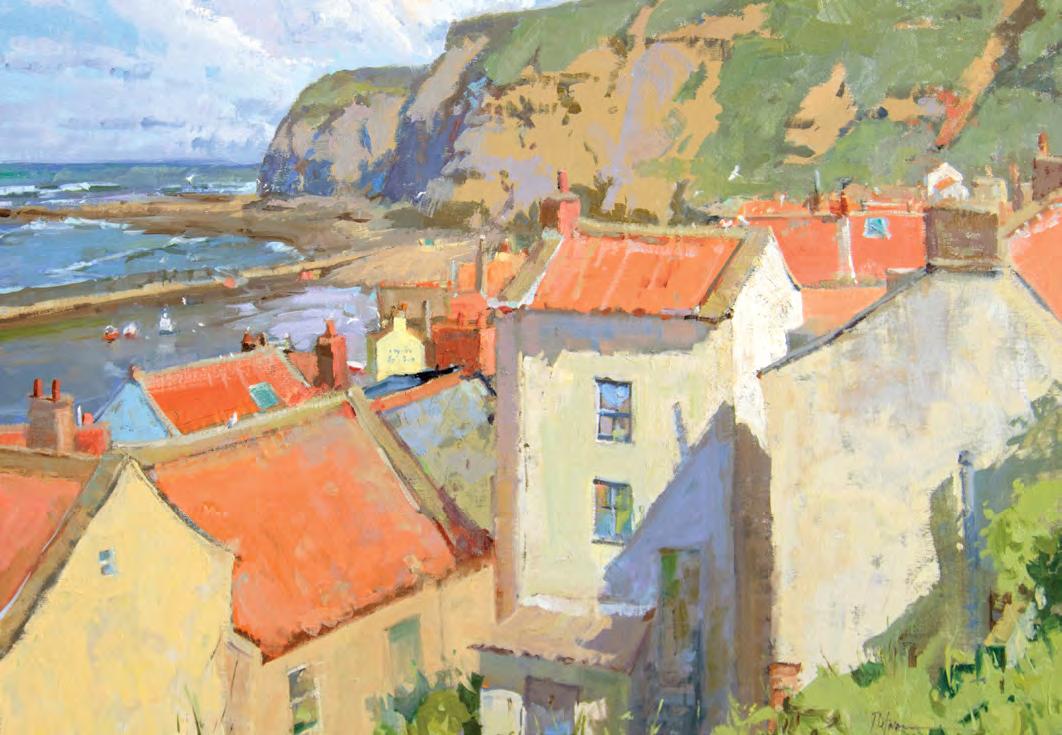
SECOND & COMMERCE / 15 we can help with that clarksville’s premier coworking space
New Deal Intrigue
BY FRANK LOTT, EXECUTIVE DIRECTOR
THE MYSTERY OF CLARKSVILLE’S MISSING MORA MURALS
With six partial columns lining a block of North Second Street, what became known locally as the “Federal Building” brought a classical revival twist to Downtown Clarksville in 1935. Boasting marble floors, large windows and broad steps leading to the street, this iconic structure originally housed Clarksville’s second post office... and a mystery that has captured the curiosity of local art and history enthusiasts for decades.
During the 1930s, as America struggled through the Great Depression, the federal government supported the arts in unprecedented ways. One such way was by decorating the walls of U.S. Post Offices with original murals created by well-known, but out-of-work, artists. Federal buildings constructed during President Franklin D. Roosevelt’s New Deal were considered ideal locations for displaying images of the “American scene.”
Social realism painting, though popular at the time, was discouraged. Therefore, scenes of jobless citizens standing in bread lines are not to be found on post office walls. Instead, artists were encouraged to depict more “heroic” images of America at its best.
“Often mistaken for WPA art, post office murals were actually executed by artists working for the Section of Fine Arts,” explained Patricia Raynor, museum specialist and loan coordinator at the Smithsonian’s National Postal Museum. “Commonly known as ‘the Section,’ it was established in 1934 and administered
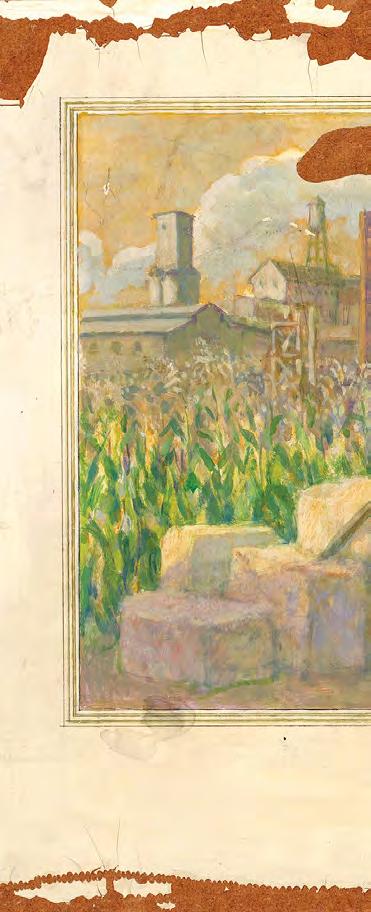

by the Procurement Division of the Treasury Department.”
Directed by artist and former businessman Edward Bruce until his death in 1943, the Section was responsible for selecting art to adorn federal buildings. “Artists working for the Section were not chosen on the basis of need, but through anonymous competitions where the national jurors were often other artists,” said Raynor. “For smaller competitions, the jury might consist of the postmaster, a member of the architectural firm and a prominent citizen.”
Artists were paid from the building’s construction funds, one percent of which were to be designated for the “embellishment” of the building. Those selected were encouraged to pursue subjects of local interest.
“Once awarded a commission, the mural artist engaged in an oftenlengthy negotiation between the Post Office Department, the town and the Section before finally getting the finished mural on the wall.
16 / SECOND & COMMERCE

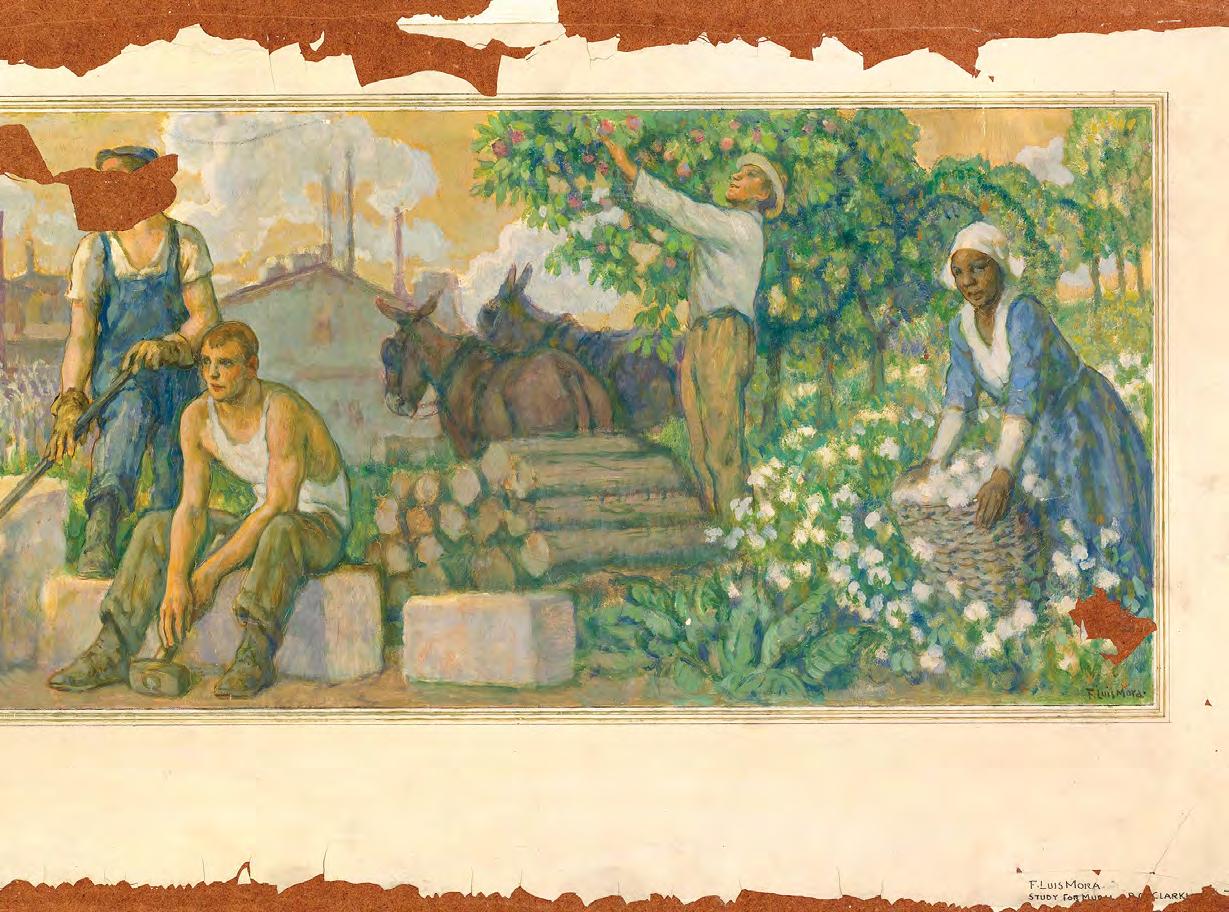 Arrival of Colonel John Donaldson [sic] (design for mural) F. Luis Mora, 1938 Courtesy of Smithsonian American Art Museum
The Abundance of Today (mural study, Clarksville, Tennessee Post Office)
F. Luis Mora, 1938 Courtesy of Smithsonian American Art Museum
Arrival of Colonel John Donaldson [sic] (design for mural) F. Luis Mora, 1938 Courtesy of Smithsonian American Art Museum
The Abundance of Today (mural study, Clarksville, Tennessee Post Office)
F. Luis Mora, 1938 Courtesy of Smithsonian American Art Museum
Many local communities deemed the approved designs unacceptable due to theme, content, method of expression or design elements,” Raynor continued. “Artists were constantly reminded that the communities were their patron, and they went to great lengths to satisfy the desires of everyone involved in the project in order to save their commissions.”
Raynor described the murals as a “truly democratic art form,” crediting the fact that “post offices were located in virtually every community and available for viewing by all postal patrons.”
IN 1937, NATIONALLYrenowned artist Francis Luis Mora was commissioned by the U.S. Treasury Department and sent to Clarksville with an assignment to paint and install two original canvas murals in the newlycompleted U.S. Post Office located at 116 North Second Street.
Born in Uruguay in 1874 to an artisticallyinclined family, Mora later settled in New York City, where he established himself as an award-winning illustrator, portraitist and muralist. His credits include everything from illustrations in Harper’s Weekly, to World War I motivational posters, to a posthumous portrait of President Warren G. Harding. He taught illustration and life classes at several New York art schools, counting Georgia O’Keeffe among his students at the Art Students League. Sadly, by the 1930s, commissions and other work opportunities became few and far between.

Mora’s two murals were inspired by a book about Clarksville titled Through the Mist of the Years written by Rev. Arthur E. Whittle, a former rector at Trinity Episcopal Church on Franklin Street. The first mural depicted the arrival of Colonel John Donelson and the Renfroe family by flatboat at the confluence of the Cumberland and Red Rivers on April 12, 1780. According to an article in the January 20, 1938 edition of The Clarksville Leaf-Chronicle, Mora titled the piece Arrival of the Renfroe Family. The article
TOP: Site for the Clarksville, TN post office
Photographer unknown, 1934
Archives Collection, Customs House Museum & Cultural Center
MIDDLE: Construction of a post office in Clarksville, TN, looking northwest Photographer unknown, Nov. 27, 1935
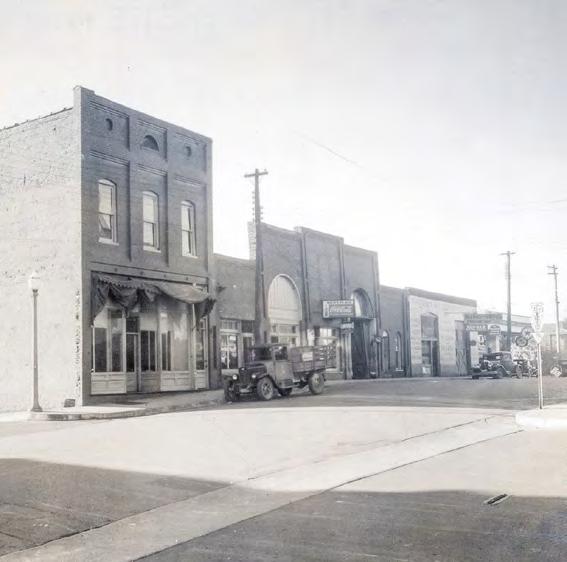

Archives Collection, Customs House Museum & Cultural Center
BOTTOM: U.S. Post Office, Clarksville, Tenn. Postcard, ca. 1940
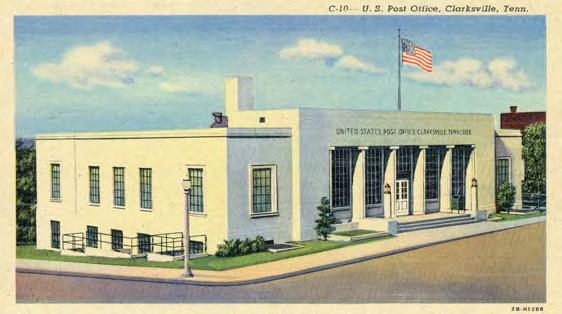
18 / SECOND & COMMERCE
F. Luis Mora (1874-1940)
Photographer unknown, 1910 Courtesy of Wikimedia Commons
Austin Peay State University Felix G. Woodward Library, Archives & Special Collections
states, “The faces of this ill-fated little band of hardy settlers show strong character and great willpower. In the distance on the river can be seen the boat that brought the first white people to this community. The figures, of course, are dressed in rough pioneer clothing.”
The second mural, titled The Abundance of Today, depicted the agricultural, industrial and business life of Clarksville as it was at the time of the painting. This mural showed laborers with factories, stores, farms, cotton and tobacco.
The Smithsonian American Art Museum retains two small full-color studies done by Mora, one for each of the proposed murals, that he submitted for approval before painting the final large canvases. Interestingly, the Smithsonian’s
Feb. 22, 1938
F. Luis Mora 58 West 57th Street New York, NY
Mr. Forbes Watson Advisor Section Painting and Sculpture Treasury Department Washington, DC
Dear Forbes:
You no doubt have us down (by this time) as one of the most hopeless cases that it has been your pleasant experience to run into. In the turmoil of things, I have truly snarled up my dates, (excepting as regards my work), and have done nothing this past month, but dig out letters and write humble apologies. I have pounded my pectorals and cried like the monks of old, "mea culpa!" I know, by a mostcharming note I received from Rowan, that the final photographs were safely received, and that the installed panels pleased.
You ask in your last "a lucid word account of the story, and characters in your mural." I have used two extreme episodes for these compositions. First—the family of Moses Renfroe who arrived at the spot where Clarksville now stands. This was in April 1780. They were brought there by a certain Colonel Donelson who was loath to leave them on account of the many hostile Indians known to live in that neighborhood. I have pictured the group on the top of the bank overlooking the little Red River. Donelson in conversation with the elder Renfroe. While others of the little party are still coming up the bank from the "good boat Adventure." This little group of settlers subsequently went up the Red River to the mouth of Parson's Creek, and built a log house and station for their immediate comfort and better protection, which was named "Renfroe's Station." "Shortly after they were settled, every one of them, including the babies, were killed by the Indians, except a Mrs. Hill, a few miles from the Station, which still bears the honored leader's names."
documentation identifies Mora’s sketch as Arrival of Colonel John Donaldson (design for mural). Notice that John Donelson’s name is misspelled.
“Artists invited to submit design sketches for a particular post office were strongly urged to visit the site. However, this was not possible for every artist,” explained Raynor. “Distance, expense, or family commitment prevented many artists from actually traveling to the community.”
Luckily, that was not the case for Mora. He reported the details of his work, completed during his four-month residency in Clarksville, to Mr. Forbes Watson, Advisor of the Painting and Sculpture Section of the Treasury Department. The following letter from February 1938 to Mr. Watson gives insight into the artist’s planning, research, study sketches and painting of the two murals just after both had been installed in Clarksville’s newly-completed Federal Post Office:
The second panel. The Abundance of Today. Showing the many resources of Tennessee. Their tobacco—corn—cotton. Lumber and the marble of their quarries. In the background the mills and factories, giving to the composition a sense of achievement—the victory after that first sacrifice. I hope this does not sound all muddled up. Let me know if it gives you a clear idea to build on.
I know that I could have given you something with, perhaps, a better touch of letters. I have not troubled, in the belief that you will take better care of that than ever I could manage to do. Should you wish to question me further, rest assured that I will give you prompt reply this time.
With many good wishes, Yours cordially, F. Luis Mora
February 22nd 1938
SECOND & COMMERCE / 19
(Transcription of Mora’s handwritten letter provided April 27, 2005 by David Bibb, Former Acting Administrator, U.S. General Services Administration.)
In 1937, nationally-renowned artist Francis Luis Mora was commissioned by the U.S. Treasury Department and sent to Clarksville with an assignment to paint and install two original canvas murals in the newly-completed U.S. Post Office located at 116 North Second Street.

20 / SECOND & COMMERCE
Lobby of the Federal Building (Post Office)
Photographer unknown, 1938 Archives Collection, Customs House Museum & Cultural Center
The completed murals each measured five feet high by twelve feet long. They were painted on rolled canvas and installed onto the north and south walls of the post office lobby, where they remained for approximately 25 years.

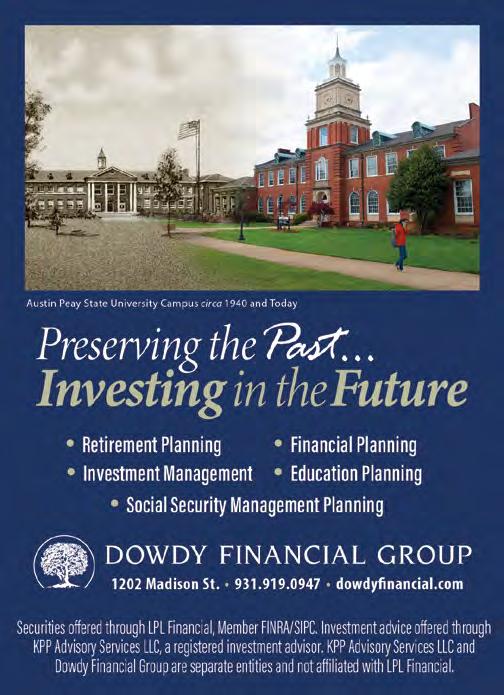
UNFORTUNATELY, CLARKSVILLE’S MURALS BY F. LUIS MORA have been lost; some sources even say “destroyed.”
During a renovation to the building in the early 1960s, they reportedly were removed and stored… but by whom and where? This has been a lingering mystery for nearly 60 years. Locally, the only remaining evidence of the murals is in the Customs House Museum & Cultural Center’s collections, which consists of two black-and-white photographs of the completed murals, plus one photo showing the mural The Abundance of Today in situ after being installed in the post office lobby.
The major body of Mora’s art spanned a period of over four decades, and he is considered by many art historians to be America’s first Hispanic Master. Mora died on June 5, 1940 in New York City, just over two years after completing the murals in Clarksville’s main post office. He was 64.
Mora’s works are currently held by or on display in over 30 museums across the country, including the Metropolitan Museum of Art in New York City and the Smithsonian American Art Museum in Washington, D.C. The Customs House Museum & Cultural Center also has 77 Mora pencil drawings and sketches, not related to the murals, in its Thomas Brumbaugh collection.
Sadly, many of the Great Depression-era post office murals across the country have disappeared due to closings, renovations or privatization. Those that have survived need repair and conservation. Communities fortunate enough to have one of these murals can enjoy a colorful record of their heritage, and give us all a glimpse of the American public's taste during a fascinating time in our nation's history.
To view and learn more about America’s post office murals or see more images, visit wpamurals.org and livingnewdeal.org.
To see more works by Francis Luis Mora in the Museum collection, visit customshousemuseum.org/collections/ explore-the-collections.
Quotes by Patricia Raynor are excerpted from the article “Off the Wall: New Deal Post Office Murals” in Volume 6, Issue 4 of Enroute the newsletter of the National Postal Museum.
SECOND & COMMERCE / 21
REINVENTING THE MAILROOM
 BY BECKY WOOD, MANAGING EDITOR
BY BECKY WOOD, MANAGING EDITOR
Breathing new life into the long-vacant Federal Building on North Second Street, The Mailroom is the newest culinary addition to Downtown Clarksville. Built in 1935 as a United States Post Office, the building has served a variety of purposes over the last 87 years, including as a fallout shelter and a local FBI office. Having sat empty since the 2010s, the new restaurant by owner Wes Cunningham takes inspiration from the building’s beginnings.
“Back in the 1930s, to communicate with your friends and family across the country or around the world, you had to go into that post office,” said Cunningham. “You didn’t text them or hop on Facebook, you went to that building to learn about what was going on in their life. We wanted to bring back that spirit, where people could come back to this space and connect with people.”
Restoring much of the original charm of the New Deal-era space, The Mailroom boasts made-from-scratch meals, craft cocktails on tap and an expansive outdoor patio. The menu is full of classic American favorites, along with international twists and entrée options cooked on an Argentinian parrilla grill.


“This is a very diverse community. People who live here now have lived all over the world,” said Cunningham. “We knew that we could be creative and do some things that Clarksville hasn’t seen yet.”


Each meal is capped off with a vintage Clarksville postcard to take home. “We wanted to do something to honor Clarksville and its history, as well as the history of this building, and send you home with something fun,” explained Cunningham. “Most people will agree that when you get a piece of handwritten mail nowadays, it means a lot.”
Above the open-concept kitchen, the restaurant pays an abstract homage to the original F. Luis Mora murals with a brand-new work by local artist Olasubomi Aka-Bashorun. The Abundance of Today by Mora showed Clarksville as it was in the 1930s, and AkaBashorun's mural brings that concept to modern day. As your eye moves from left to right, the piece adds more color, dimension and vibrancy – just as the city is always evolving and improving.
mailroomtn.com @mailroomtn
22 / SECOND & COMMERCE
Photos by Ava Vienneau
A

COLLECTIONS SPOTLIGHT: HALLOWEEN DELIVERED
 BY KATE TALLMAN, COLLECTIONS ASSOCIATE
BY KATE TALLMAN, COLLECTIONS ASSOCIATE
The spirit and traditions of Halloween in America have been immortalized in large part by the popular early 20th-century custom of picture postcards.
The most popular Halloween ephemera are from the “Golden Age” of postcards, which began in the United States with the Private Mailing Card Act of 1898, peaked in 1910 with the introduction of tariffs on German-printed postcards and lasted until about 1918. Cost effective and bursting with opportunity to showcase personality, the heyday of postcards marked large events like baby showers and weddings, as well as smaller holidays, sympathies and playful correspondence between neighbors.

The earliest postcards were the products of Raphael Tuck, a German postcard manufacturer who popularized the exchanging and collecting of illustrated cards in rich colors. Other manufacturers were the John Winsch Company, whose cards were also printed in Germany, and the Gibson Art Company of Cincinnati, best known for popularizing the “Gibson Girl” icon. Popular Halloween imagery during this time included games like apple bobbing or apple stringing, black cats, witches and carved vegetables like turnips and pumpkins. Interestingly, skeletons or more direct nods to death rarely, if ever, appear at all. There was, however, a popular figure that has since faded from contemporary Halloween celebrations. Rotund pumpkin people with carved faces, gourd-like appendages and pumpkin leaf collars frequently interacted with Halloween traditions on postcards. Sometimes referred to as “bogie men,” this may have been a nod to the Celtic origins of the holiday.
This postcard, posted circa 1910, depicts a carved jack-o-lantern, black cat and pumpkin person character popular at the time. Also postmarked on October 30, this trend in our collections indicates that for many in Clarksville, sending Halloween Eve postcards was a tradition in itself.

 gilt embossed postcard from Raphael Tuck & Sons Company depicting a little girl and her cat Josephine. The girl stars in a set of ten playful situations, all occurring around “Hallowe’en” with Josephine often joining her. This card was printed in 1911, at the start of the series’ printing.
gilt embossed postcard from Raphael Tuck & Sons Company depicting a little girl and her cat Josephine. The girl stars in a set of ten playful situations, all occurring around “Hallowe’en” with Josephine often joining her. This card was printed in 1911, at the start of the series’ printing.
Mailed on October 30, 1922, this Whitney Made postcard features the symmetry and bold colors popular in Art Deco print design. The all-caps “Hallowe’en Greetings” illustrates the triangular character shapes common in Art Nouveau typefaces.


The most prolific illustrator of the Halloween genre was Ellen Clapsaddle, an American painter from South Columbia, New York.


Ellen was a freelance artist who specialized in postcards, greeting cards, advertising fans and calendars. She is most famous for her more than 3,000 illustrated postcards, most of which depict cherubic children in holiday scenes. She was so successful that she was able to move to Germany and invest heavily in the printing houses dominating the industry. Unfortunately, World War I devasted the connections between American consumers and German postcard manufacturers, as well as many of the physical factories, leading to the end of the golden postcard era. Sadly, Ellen died penniless and largely unknown the day before her 69th birthday. It was not until decades after her death that her contributions to the American Halloween aesthetic were fully appreciated.

A whimsical Halloween postcard featuring a poem and printed by Whitney Made, the correspondence company credited as the king of the “valentine empire.” In 1915, Worcester Magazine assessed that “ninety per cent of the valentines that are exchanged on St. Valentine’s Day come from Worcester.” This particular card was mailed on October 30, 1924.
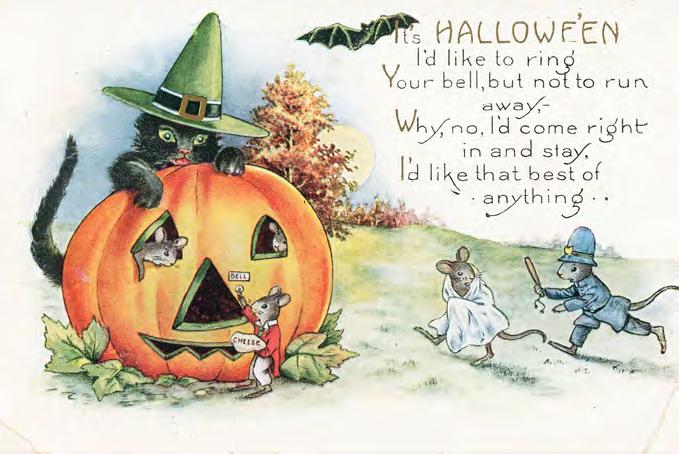
“A Jolly Hallowe’en” by Ellen Clapsaddle. This design, in series 978, was printed by the International Art Publication Company in 1909 and features the colorful depictions of witches common at the time, most often appearing in red, blue or green.


The cards featured here were donated by Finley Elder Gracey and Montgomery Davie in 1984, making them some of the earliest items accessioned into the Customs House Museum & Cultural Center’s collections. While the “Golden Age” of postcards has come and gone, these foundational artifacts live on in the archives.




View more vintage holiday postcards, from Christmas greetings to heartfelt valentines, at customshousemuseum.org/collections/explore-thecollections.

SECOND & COMMERCE / 25 Historic Downtown Clarksville THE ONLY CICCHETTI BAR IN TN CRAFT COCKTAIL BAR FULL SERVICE COFFEE BAR CLARKSVILLE’S ONLY TRUE WOOD FIRED PIZZA OVEN 111 Franklin Street
BREAKFAST LUNCH DINNER

 Wooden Ornament, $20 Woodturning by Jack Bastin Clarksville, TN
Blown Glass Ornament, $25 Thomas Spake Studios Chattanooga, TN
Ceramic Ornament, $28 Anne K. Beyer Calvert City, KY
Hand-painted CHM&CC Ornament, $19.95 Customs House Museum & Cultural Center Clarksville, TN
The holidays
Wooden Ornament, $20 Woodturning by Jack Bastin Clarksville, TN
Blown Glass Ornament, $25 Thomas Spake Studios Chattanooga, TN
Ceramic Ornament, $28 Anne K. Beyer Calvert City, KY
Hand-painted CHM&CC Ornament, $19.95 Customs House Museum & Cultural Center Clarksville, TN
The holidays
are right around the corner! Shop handmade gifts, décor and other local goods at Seasons: The
Museum Store.
COMING

Limited Edition Dan Hanley Christmas Cards

The Customs House Museum & Cultural Center is delighted to offer boxed sets of special edition Christmas cards featuring the illustrations of one of Clarksville’s favorite artists, Dan Hanley. For over 20 years, Dan created hand-colored works of art with festive themes and sent these cards to his family and friends. Anyone fortunate enough to be on his holiday list looked forward to receiving one of his special greetings with child-like anticipation.
Now YOU can deliver this Christmas cheer by purchasing a boxed set of Dan Hanley card reproductions. Dan’s wife, Jody, has given the Museum permission to reproduce all 24 of Dan’s cards and make them available as a fundraiser. Different sets of six will be available over the next four years.
Quantities are limited! Pre-order now by calling Seasons: The Museum Store at 931-648-5780 ext. 2039.
SECOND & COMMERCE / 27
to serve
Clarksville , TN BEST PLACE TO LIVE ~ 2019 Money.com #1
Proud
the community that we love so much.
THIS NOVEMBER!
Dan Hanley Christmas Card Set of 12, $24.99
HIGHLIGHTING TENNESSEE ARTISTS
 BY BECKY WOOD, MANAGING EDITOR
BY BECKY WOOD, MANAGING EDITOR
Making art is often a solitary process, but artist associations across the globe offer creative community, opportunity and outreach for their members. Two such organizations, the Nashville Artist Guild and the Tennessee Watercolor Society, have long histories of supporting the creative journeys of artists throughout Middle Tennessee and beyond.
THE NASHVILLE ARTIST GUILD
The oldest juried membership art guild in Tennessee

In 1950, two art teachers from Vanderbilt University brought together students and local professional artists to create a new and unique organization. Beginning with those original 30 artists, the Nashville Artist Guild has grown to serve hundreds of artists over the last seven decades.
The Guild is a nonprofit, juried organization of professional artists, irrespective of any particular school, style or movement. Beyond providing their members with venues for exhibiting and selling their work, the organization works to promote art as an integral part of Nashville life and to provide educational programs for the public.
Their newest exhibit at the Customs House Museum & Cultural Center will showcase over 50 works of art juried by Terri Jordan, Curator of Exhibits. Patsy Sharpe, local Clarksville artist and former president of the Guild, says Museum visitors can expect a show from a diverse collection of artists and mediums. “There is such a wide variety of kinds of art that you’ll see,” said Sharpe. “We have an encaustic painter, several watercolorists, oil painters, pastel artists... it makes for some really interesting contrast throughout the show.”
28
Art of the
is on view in the
from
to
nashvilleartistguild.org @nashvilleartistguild
Nashville Artist Guild
Kimbrough Gallery
October 4
November 27.
TOP: Big Oak at Grace Chapel
Frank Lott Watercolor, 22x30
BOTTOM: Shooting Stars
Pat Patrick Watercolor, 19x13
OPPOSITE PAGE TOP: Firewater Patsy Sharpe Watercolor, 11x15
OPPOSITE PAGE BOTTOM: Fallen Giants
Janet Felts Acrylic, 10x20
THE TENNESSEE WATERCOLOR SOCIETY
Elevating, educating and encouraging through the magic of watermedia
Active since 1971, the Tennessee Watercolor Society (TnWS) is a membership organization dedicated to elevating the stature of watercolor painting and educating the public about the significance of the art form.

Celebrating 50 years, the 2022 Juried Biennial Exhibition was held this past spring at the Association for Visual Arts in Chattanooga, complete with 60 original watermedia paintings selected from 200 entries. Paintings by three Clarksville-area watercolor artists were selected for inclusion in the show: Frank Lott’s Big Oak at Grace Chapel , Yuson Yi’s Sweet Landing and Pat Patrick’s Shooting Stars
“The Watercolor Society offers the opportunity to share technical information and build community,” said Patrick. “It also shares publicity for other exhibitions and activities that various artists and members are doing.”
A traveling exhibit of 30 paintings chosen by the juror, renowned international artist Stan Miller, has journeyed through different galleries across the state and will culminate in Clarksville at the Customs House Museum & Cultural Center. The traveling show is made possible by its sponsor, the Lyndhurst Foundation in Chattanooga.
TnWS has over 250 members centered around the principal cities of Memphis, Nashville, Chattanooga, Knoxville, Tri-Cities and Clarksville. “The organization is actively working with the art community in their regions,” said Yi, who currently serves as the vice president of TnWS. “As a member, you get to see many artists who have excellent talent and a lifetime of experience in pursuing art... you learn a lot. It is very encouraging and motivating to have these opportunities to grow and expand as an artist.”
The Tennessee Watercolor Society’s Biennial Exhibition makes its way to Clarksville on December 1 and will remain on view in the Kimbrough Gallery until January 29, 2023.
tnws.org

SECOND & COMMERCE / 29
The Post Office
BY CRESTA MCGOWAN
The post office is a magical place. That is a bold statement, given it isn’t a castle with wands or an adventure through Middle Earth, yet it holds more enchantment for humanity than all the worlds of fiction. The post office carries our secrets – our wild unknown desires across the world, and it’s the communication we cherish most because the words, the gifts, the packages live and breathe in us. It reveals triumphs and tribulations with the simplicity of a postcard and a stamp, and we save this art throughout time immemorial.
The Customs House Museum & Cultural Center here in Clarksville, with its timeless beauty, used to be the local post office. Built in 1898 and considered quite flamboyant in its structure, it was home to the communications of the past. It existed when mail lived as loopy script across paper with deliberately chosen words. Magical. But with time, the post office moved down the street, and that is now a new venue for dining paying homage to its roots as “The Mailroom.” Modern post offices populate our city en masse, and many of us probably don’t know our mail person's name despite the daily visit to our homes. Over time, the excitement of “snailmail” abated with electronic transmission and texting taking over the “page.” Letters have become something scoffed at with little appreciation for the time it takes to write in script, to carefully consider our phrases, to reflect on what to say and how to say it.
My grandma ran the local post office out of a mint green shot-gun house in Creedmoor, Texas. I helped her in this small relic of the past while she drank coffee and smoked Lucky Strikes. She always had a cigarette in her wrinkled lips, her jet-black hair in a bob above her shoulders. I don’t remember her hairstyle ever changing or even a slip of gray disrupting her locks, even through the cancer that took her from me. She would let me sit on the front counter and greet people as they came in to mail their letters before the days of self-service and internet shipping, and she talked and laughed and knew everyone and everything in their tiny slice of the world. When mail came in from Austin, I helped her sort it, placed the epistles in twenty or so rusted cubby holes with numbers delegating their proper person. When the day was slow and heat dragged into the summer of Texas, she let me sit on the back counter and play with the postage stamps. Not the self-sticking square of today, but a bevy of wooden carved rubber stamps with important information embossed on each. I would take envelopes and create designs and artful masterpieces with my stamps and ink.

30 / SECOND & COMMERCE
THE
POSTSCRIPT
Post
Office, Clarksville, Tenn. Postcard, n.d.
Austin Peay State University Felix G. Woodward Library, Archives & Special Collections
This time with her, with letters, has never left me. When my husband and I left junior college, we went our separate ways to separate states. He joined the Army, and I went on to university. We wrote a few letters, mostly sappy love prose (on my behalf) and general upkeep, because back then, long-distance phone calls were expensive and the impersonal abbreviations of text didn’t exist. But in July of 1999, I wrote him a letter and bared my soul. I wrote my love down on cream colored paper with red and pink flowers about the edge. I wanted to know if he was still in love with me, because I was still in love with him. I chose my scripted words carefully. We were married in July of 2000, one year later. I think about that letter. How it went through the steps of the post office, the mail truck, the transition into bins and the placement into his mailbox. I think about his reply and how we slipped back together as if never apart, how the words I wrote by hand, this form of communication, became the way the love of my life returned to me.
The post office is more than a place to send things. While it seems on the surface a business of impersonal transactions, what comes to pass in this somewhat sterile environment is deeply personal. Ernest Vincent Wright talks of mail in his novel Gadsby. He shares the idea that mail, a postcard, a piece of paper, a stamp means nothing in the world until they cross the partition into action. It is there that “a magical transformation occurs; and anybody who now should willfully purloin it, or obstruct its trip in any way, will find prison doors awaiting him.”
My grandma never saw the inside of a massive post office like the one the Museum used to be, nor did she dine in restaurants with names showing loyalty to time gone by. But she played her role in this heartfelt communication. The little post office in Creedmoor, TX isn’t there anymore, and my husband never met my grandma or saw the magical place with vintage rubber stamps. Yet, as I wrote those words to my now husband and held my breath, I believe she smiled in Heaven, guided my hand as I composed my heart on the page, jet black hair, holding a Lucky Strike.

SECOND & COMMERCE / 31
There’s always something going on at the Museum. Share your visit with us! Tag us for a chance to be featured on our social media, in the Museum or right here in Second & Commerce.


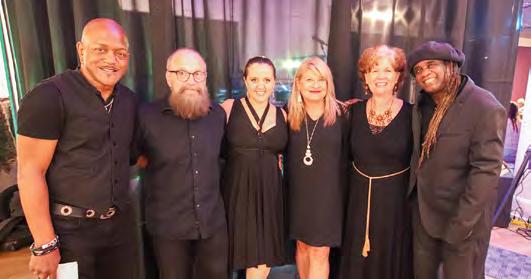
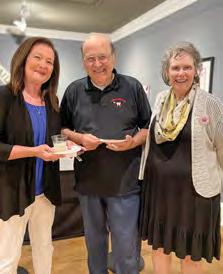
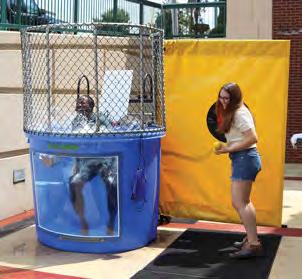




32 / SECOND & COMMERCE
CONNECT WITH US customshousemuseum.org @customshousemuseum #customshousemuseum
@yow.erin
Gracie Garrison
@caponyourleft
Kimmy's Christian Academy


Clarksville Montgomery County Historical Museum d.b.a.
NONPROFIT ORG. U.S. POSTAGE PAID CLARKSVILLE, TN PERMIT NO. 530
P.O. Box 383 Clarksville, TN 37041 customshousemuseum.org